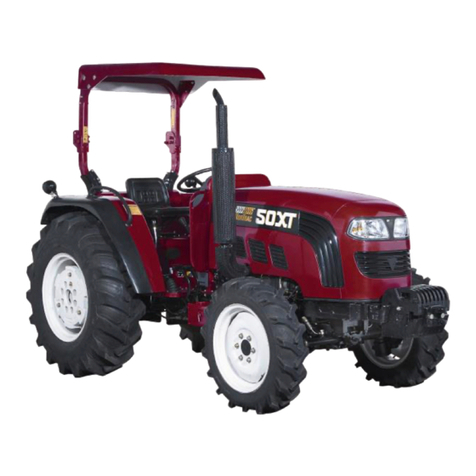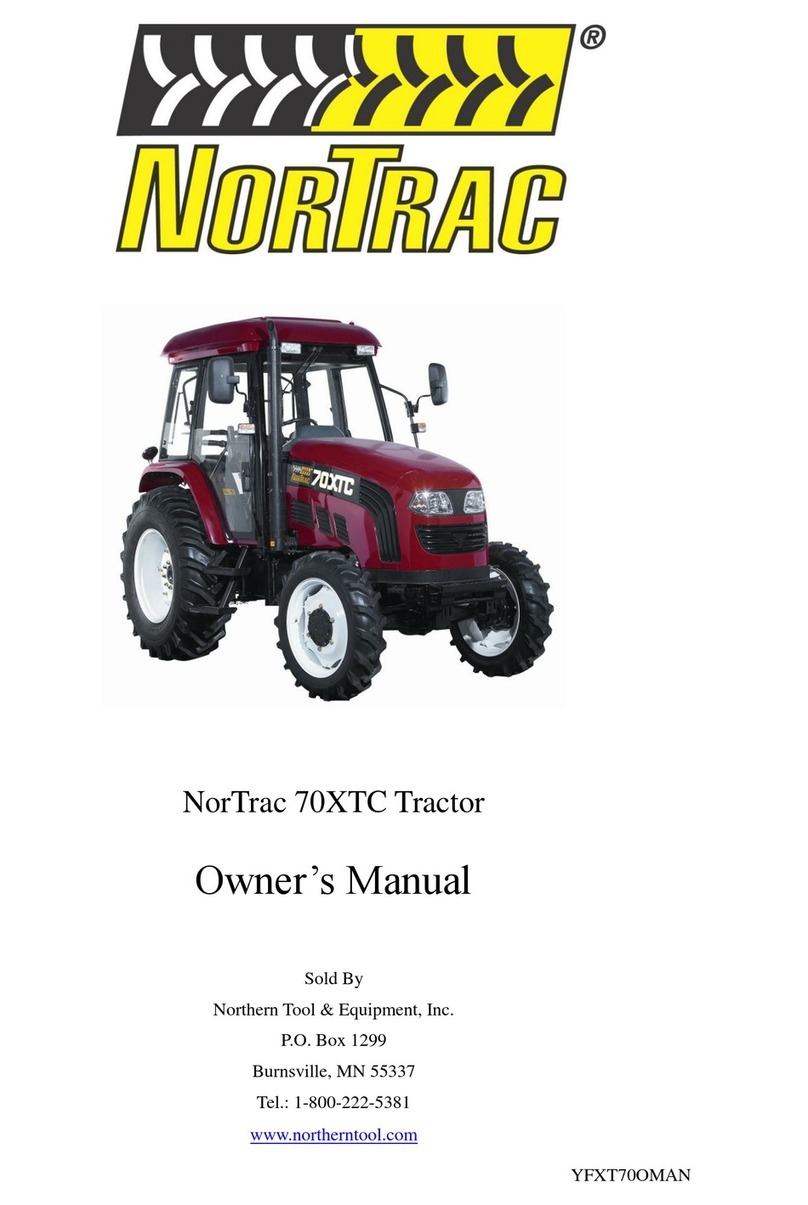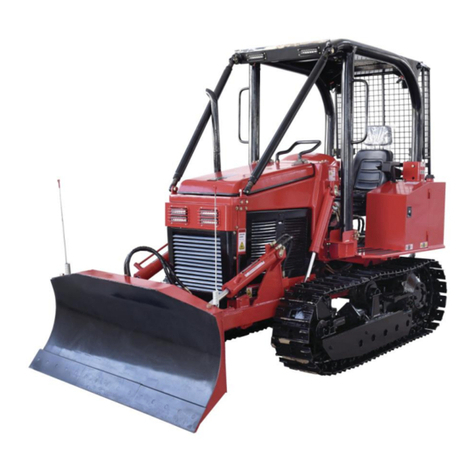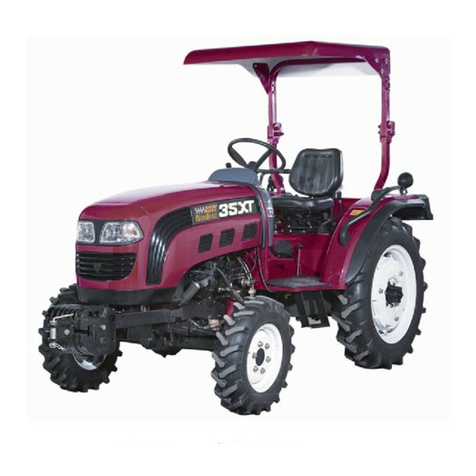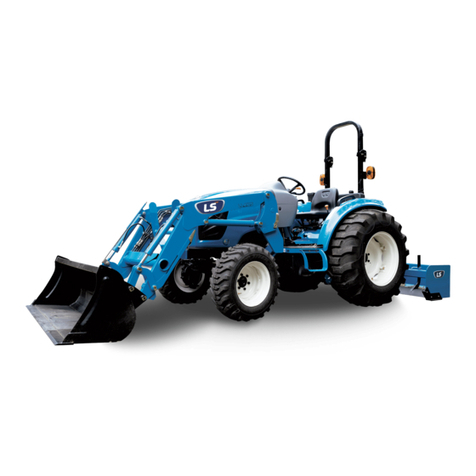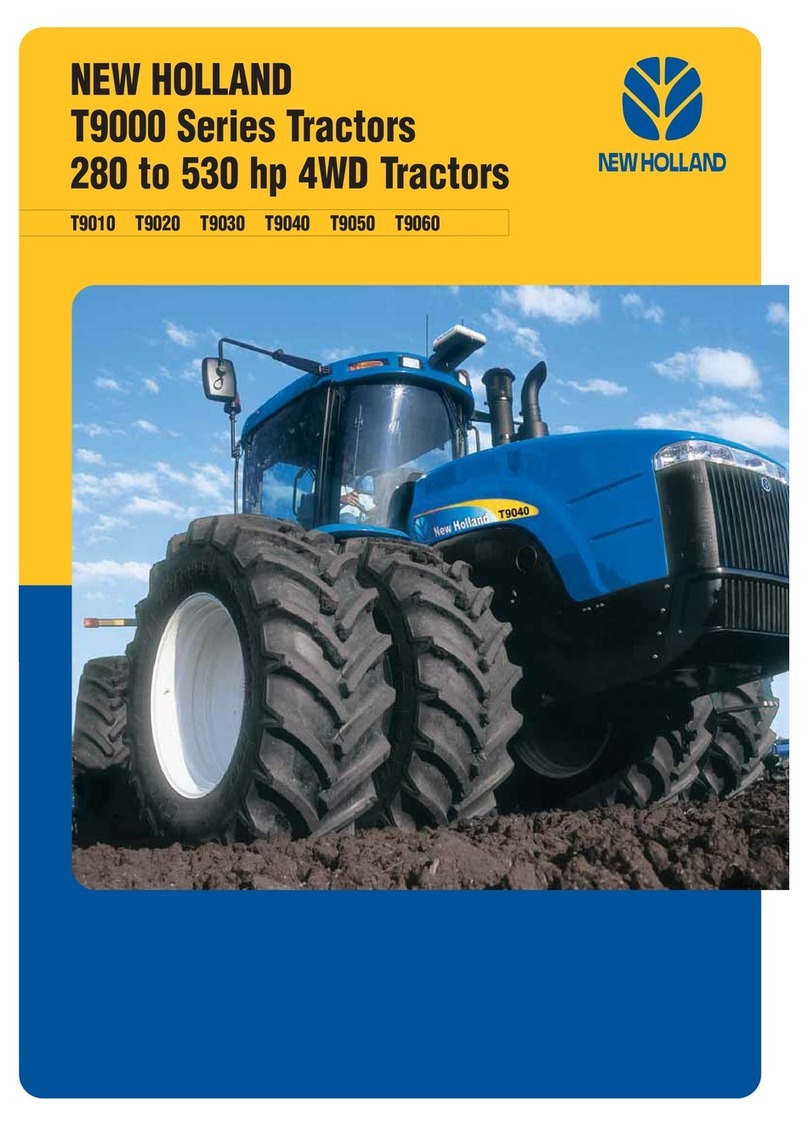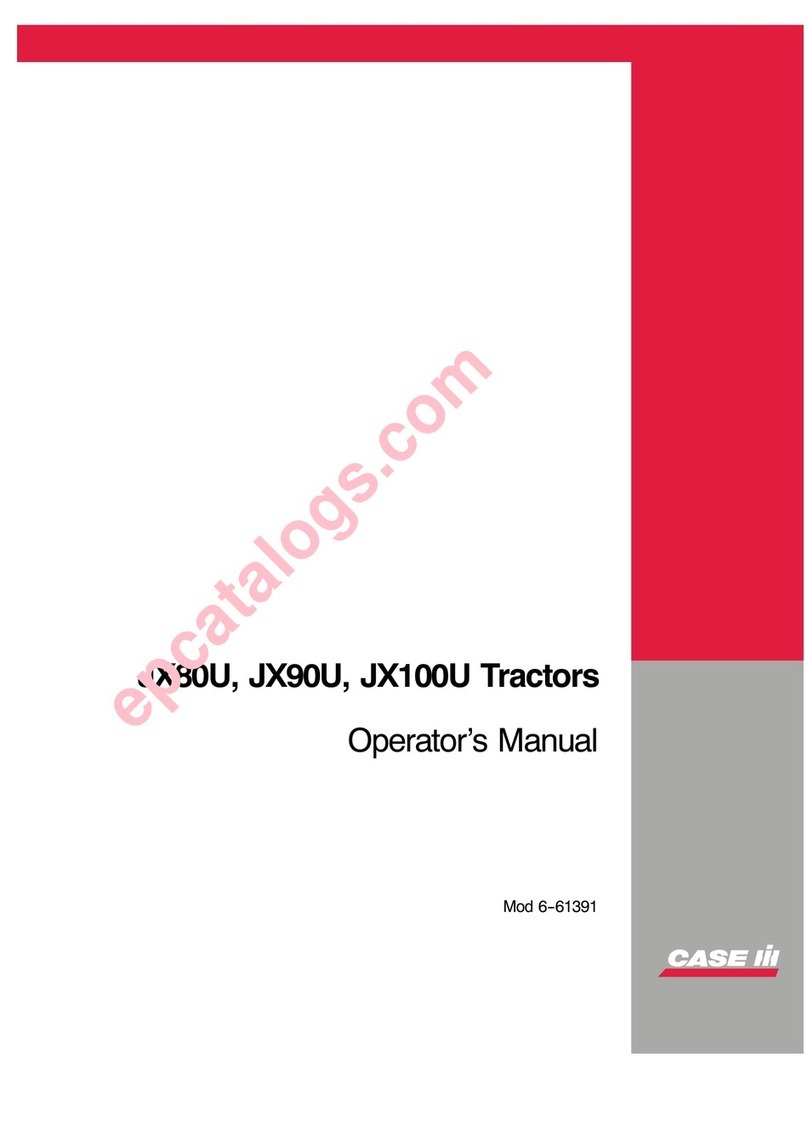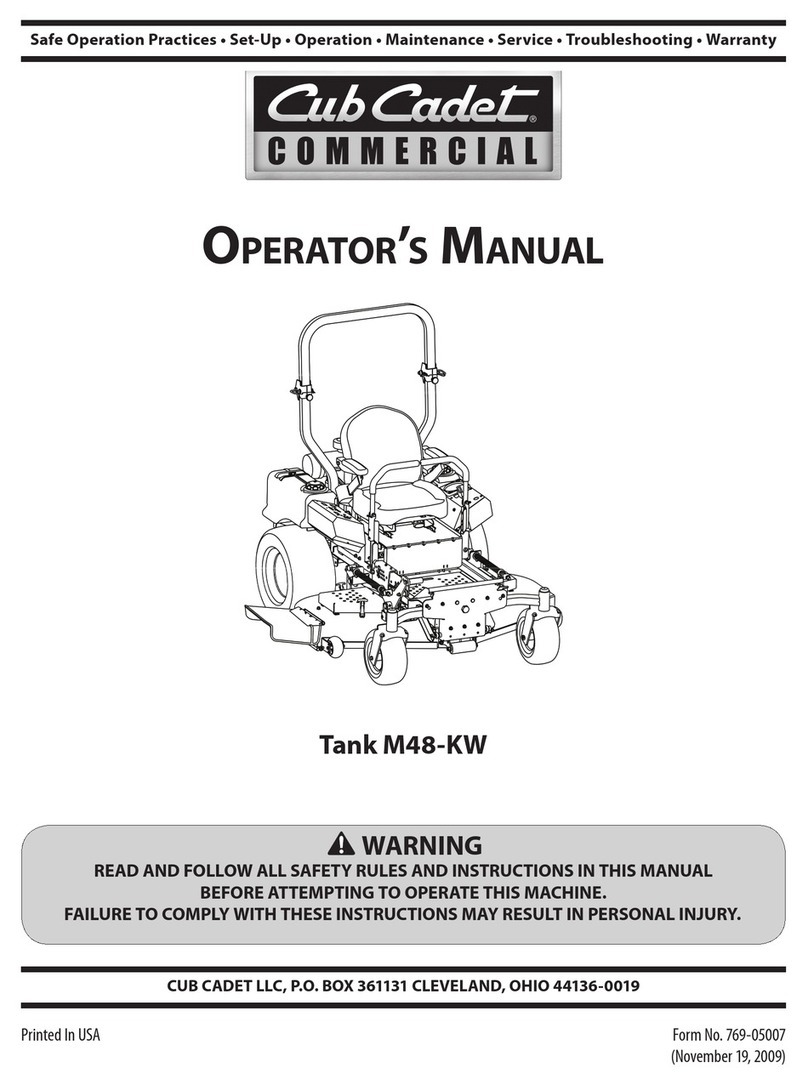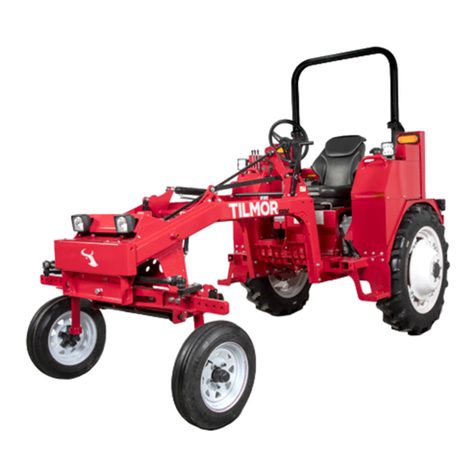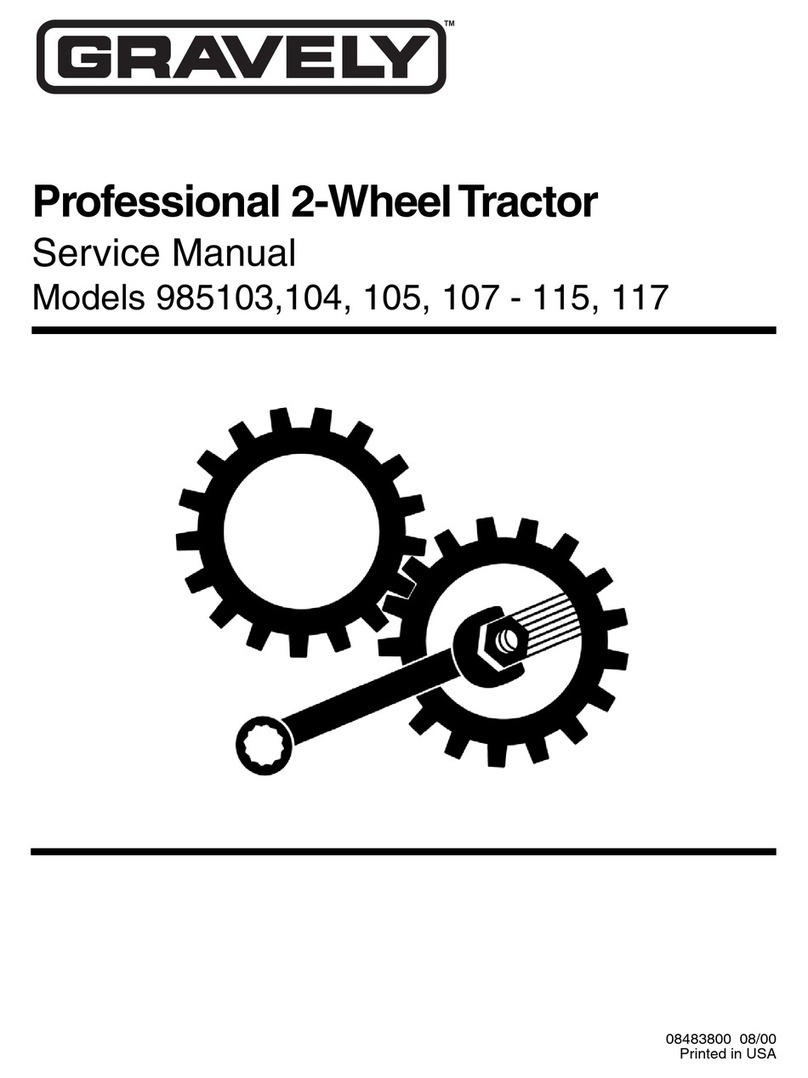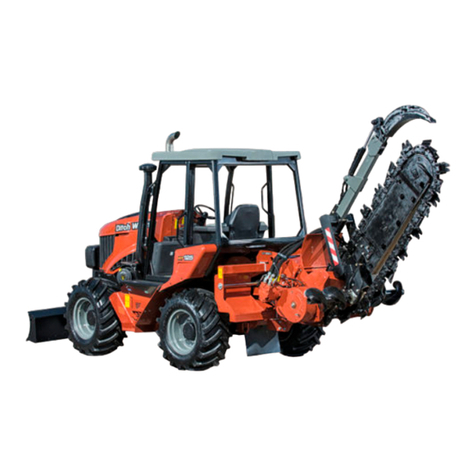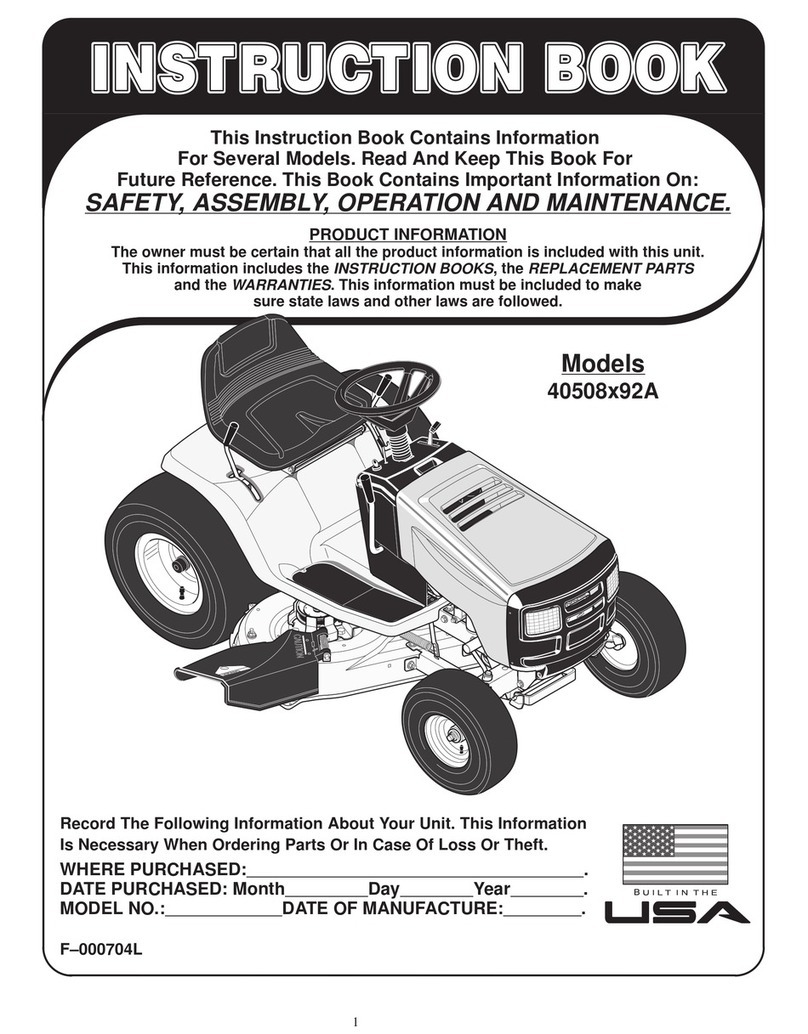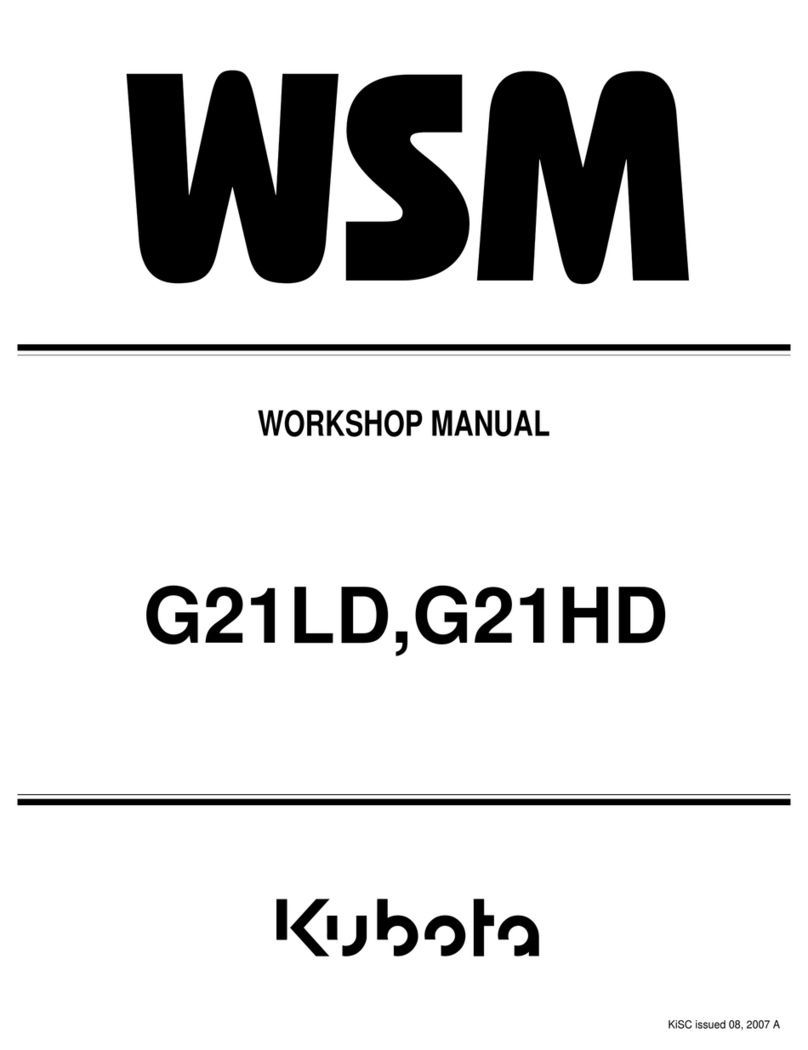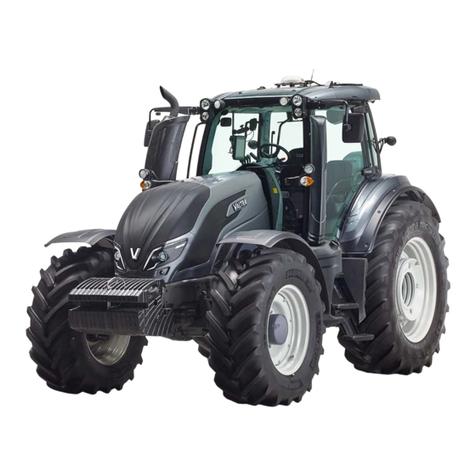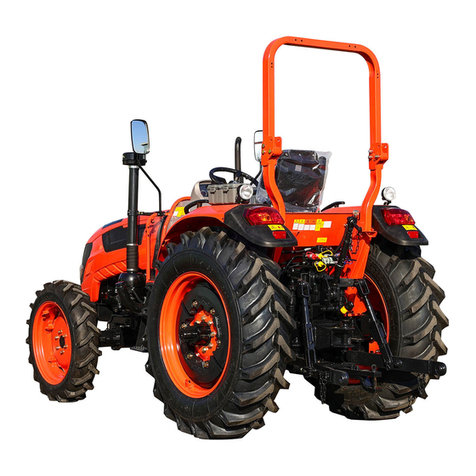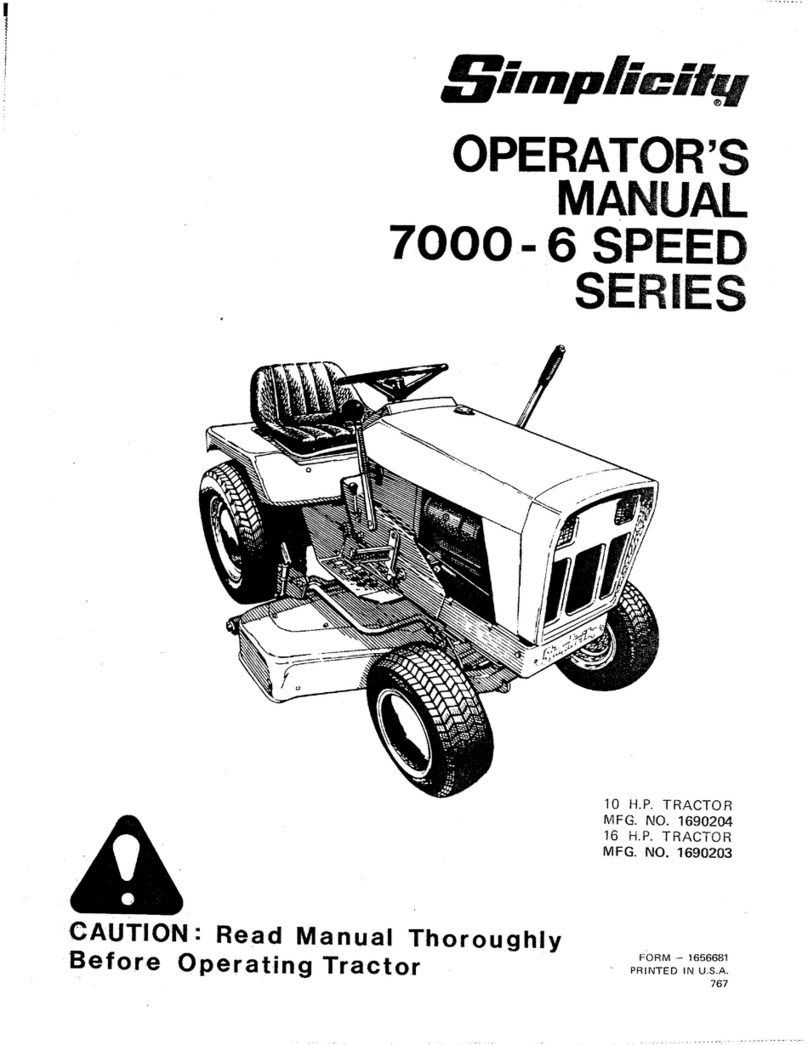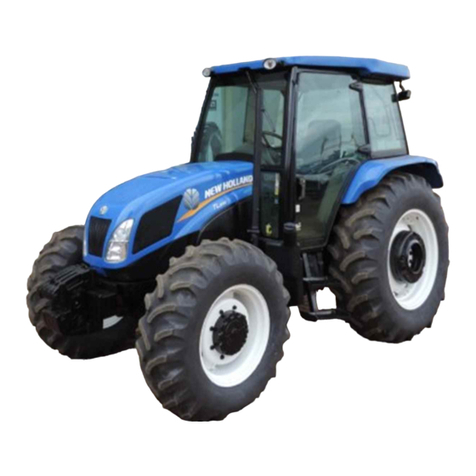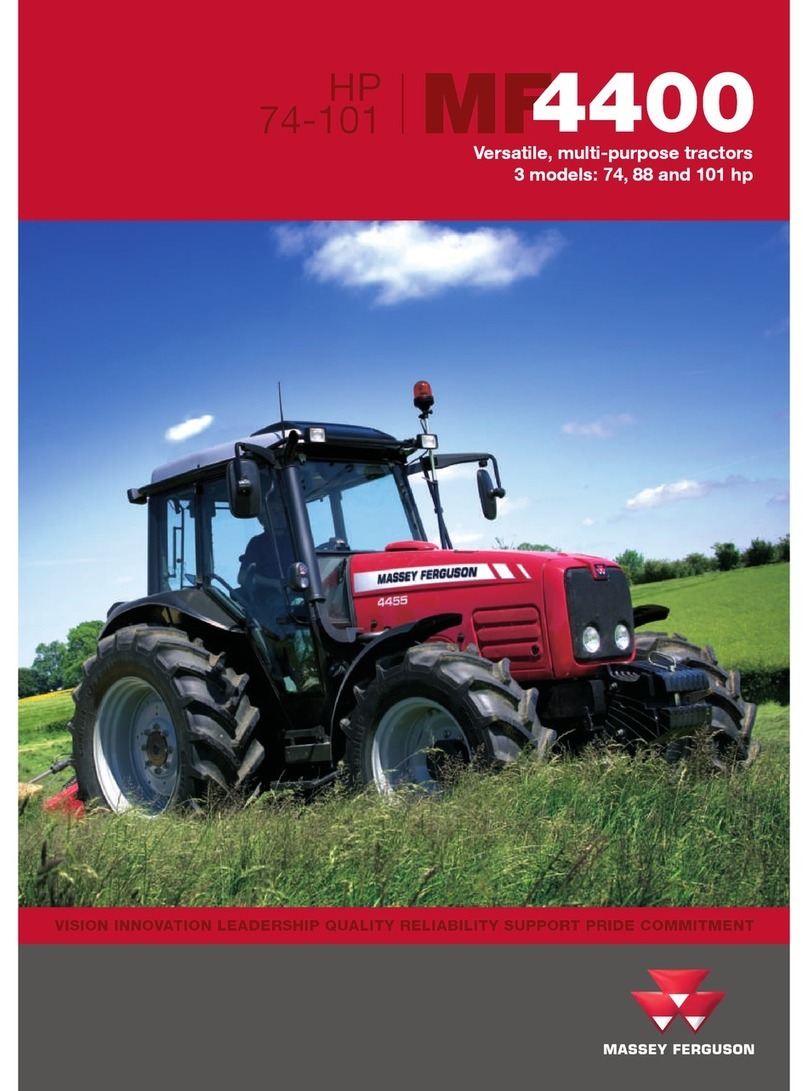Nortrac 82XTC User manual

NorTrac 82XTC Tractor
Product Identification Data Sheet
Product Part Number
Product Model
Machine Serial Number
Chassis Serial Number
Engine Model
Engine Serial Number
Date of Purchase
Where Purchased/Contact
Information
Owner Name
Complete this form carefully at purchase.
All SN’s in this form should be recorded completely (including letters).
Distributed by
Northern Tool & Equipment Co., Inc.
Burnsville, MN 55306-6936
Made in China

User Notices
Thank You
Thank you for purchasing a NorTrac tractor from Northern Tool + Equipment Company. We value you as a
customer and wish you many years of safe and satisfied use of your tractor.
Using Your Owner’s Manual
This Owner’s Manual is an important part of your tractor and should remain with the tractor if you sell it.
Failure to follow the tractor break-in procedure will void the warranty on the tractor.
Read this Owner’s Manual to help you and others avoid personal injury or damage to the tractor. This manual
provides information on the safest and most effective use of the tractor. It will help you and others you might train
to operate the tractor safely and correctly.
If you use the tractor with an implement or other attachment, use the safety and operating instructions in the
owner’s manual for that implement or attachment along with this Owner’s Manual so you can operate the
implement safely and correctly with the tractor.
While the tractor shown in this manual may differ slightly from your tractor model, the instructions in this manual
will apply to your manual unless otherwise stated.
Disclaimer
The 82XTC tractor and its components may be changed by the manufacturer at any time without notice and may
not correspond to the contents of this Owner’s Manual.

Overview
This manual describes safety precautions as well as running-in, proper usage, technical maintenance, adjustment,
faults and troubleshooting methods for various parts of the Nortrac XTC tractors. The manual gives an in-depth
look and should be used as a reference tool for owners and maintenance personnel.
In this manual, the safety alert symbol prompts important safety information. When this
symbol is seen, you should be alert to possible injuries or affects to the service performance of the machine.
WARNING: Alerts you to safety hazards that could result in serious injury or even death.
NOTICE: Alerts you to actions that could result in minor injuries or could damage the tractor
or its’implements and thus result in possible safety hazards.
IMPORTANT ISSUE: Issues that may result in damage to the tractor, related machinery and/or
the environment.
NOTE:Provides additional information on a given topic.
Please read the messages that follow the symbol carefully and make other operators aware of any potentially
hazardous situations. This manual is an integral part of the product and should be kept with the tractor.
Please keep it in a safe, dry place. If you encounter any sections that you do not understand while going
over the manual, please call 1-952-641-2592 for assistance.
Only those familiar with this manual and the characteristics of this machine should be allowed to
operate, service and maintain the tractor. In addition, some government regulations specify that no
one under the age of 16 may be employed to operate power machinery. (Refer to U.S. Department
of Labor, Employment Standards Administration, Wage and Hour Division, Child Labor
Bulletin #102).
In employment conditions, current OSHA regulations state in part: “At the time of initial
assignment and at least annually thereafter, the employer shall instruct every employee in the safe
operation and servicing of all equipment with which the employee is, or will be, involved.”
Observe the accident prevention rules as well as other safety regulations and local traffic rules at all times.
The manufacturer is not liable for any damage to the machine or personal injury resulting from any
unauthorized refitting of this machine or use of the tractor for tasks that are outside the scope of the tractors
usage guidelines.

Table of Contents
Table of Contents
1. Safety Precautions....................................................................................................................................1
1.1 Safety rules and notices of use .................................................................................................................1
1.2 Safety warning symbols ...........................................................................................................................6
1.3 Preventing farm machine hazards...........................................................................................................10
2. Operating Instructions...........................................................................................................................14
2.1 Commonly used identifiers.....................................................................................................................14
2.2 Product description.................................................................................................................................15
2.3 Tractor operating mechanism and instructions.......................................................................................15
2.4 Starting the engine..................................................................................................................................21
2.5 Running the engine.................................................................................................................................24
2.6 Putting the tractor in motion...................................................................................................................24
2.7 Steering the tractor .................................................................................................................................25
2.8 Shifting gears..........................................................................................................................................26
2.9 Differential lock operation......................................................................................................................27
2.10 How to use the front axle drive ............................................................................................................27
2.11Tractor braking ......................................................................................................................................28
2.12 Stopping the tractor and engine shutdown procedures.........................................................................29
2.13 Tire assembly and disassembly ............................................................................................................29
2.14 Counterweights.....................................................................................................................................31
2.15 Driver’s seat adjustment .......................................................................................................................32
2.16 Hydraulic suspension, PTO, and electrical system operation...............................................................32
2.17 Tractor upper chassis............................................................................................................................42
2.18 Electrical schematic..............................................................................................................................47
2.19 Tractor break-in....................................................................................................................................48
2.20 Common faults and troubleshooting methods......................................................................................53
3. Accessories and Consumables ...............................................................................................................65
3.1 Accessories.............................................................................................................................................65
3.2 List of consumable parts.........................................................................................................................67
4. Maintenance Instructions......................................................................................................................69
4.1 Technical maintenance procedures.........................................................................................................69
4.2 Operation and technical maintenance.....................................................................................................73
4.3 Clutch adjustment and maintenance.......................................................................................................74

Table of Contents
4.4 Transmission adjustment and maintenance ............................................................................................76
4.5 Rear axle adjustment and maintenance ..................................................................................................77
4.6 Brake adjustment and maintenance........................................................................................................78
4.7 Steering mechanism adjustment and maintenance.................................................................................79
4.8 Four wheel drive front axle adjustment and maintenance......................................................................80
4.9 Transfer case adjustment and maintenance.............................................................................................80
4.10 Tire adjustment and maintenance.........................................................................................................81
4.11 Electrical system adjustment and maintenance ....................................................................................82
4.12 Hydraulic suspension system maintenance ..........................................................................................85
4.13Air filter use and maintenance..............................................................................................................88
5. Storage.....................................................................................................................................................89
5.1 Tractor storage causes of damage...........................................................................................................89
5.2 Tractor storage........................................................................................................................................89
5.3 Tractor storage maintenance...................................................................................................................90
5.4 Removing tractor from storage...............................................................................................................91
6. Transportation........................................................................................................................................92
7. Technical Specifications.........................................................................................................................93
7.1 Four-wheel drive tractor technical specifications...................................................................................93
8. Disassembly and Disposal......................................................................................................................98
9. Warranty Terms......................................................................................................................................99
10. Appendices ..........................................................................................................................................101
10.1 Tractor fuel, oils and solutions ...........................................................................................................101
10.2 Tightening torque table of major screws, bolts and nuts....................................................................102
10.3 Reinforced seals .................................................................................................................................103
10.4 Tractor roller bearings ........................................................................................................................104
10.5 O-ring seals .......................................................................................................................................106

Safety Precautions
1
1. Safety Precautions
1.1 Safety Rules and Notices of Use
Reading Prior to Use
1. The instructions for use, maintenance, and the safety warning
identifiers should be fully read and understood.
2. The correct usage and operating method should be observed.
3. Local traffic rules and safety regulations must be observed at all times.
Fig. 1-1 Reading prior to use
AQualified Operator
1. When operating the machine, the driver must use sound judgment.
2. Never operate the tractor if you have been drinking or are tired.
3. The driver should read and understand this operator’s manual.
4. Drive slowly at first in order to test your skill level.
Clothing
During the operation, the driver should avoid loose fitting clothing.
Baggy and bulky clothes are not recommended.
Fuel Usage
1. Diesel fuel is a combustible substance. Keep all fuel away
from open flames.
2. The engine should be shut down prior to refueling.
3. Smoking is strictly prohibited when the fuel system is
being refueled and overhauled.
4. Use a clean rag to wipe off any fuel or machine oil overflow.
5. The requirements set out in the “Appendix” must be strictly
complied with for fuel and lubricating oil quality assurance.
Fig.1-4 Use of fuel
Fig.1-2 A qualified operator
Fig.1-3 Driver’s clothes

Safety Precautions
2
Waste Oil Disposal
1.Used machine oil is a hazardous waste. Dispose of it properly.
2.The used acid from the battery is also a hazardous waste. Dispose of it properly.
Fig.1-5 Waste oil disposal
Hydraulic Line Leaks
Do not use your hand to check for leaks in the high-pressure hydraulic oil lines.
You may use a piece of cardboard or a wooden board to test for possible leaks.
Fig. 1-6 Hydraulic line leaks
Removing the Radiator Cap
Never remove the radiator cap when the engine is hot. Turn the engine off
and wait until the engine has cooled, then turn the cap to the first position.
Once pressure has been reduced, you can then remove the cap.
Fig. 1-7 Removing the radiator cap
Electric Parts Maintenance
1. Remove the ignition switch key.
2. Never service any of the tractor’s electrical components
without first removing the ground wire from the battery.
Fig. 1-8 Electric parts maintenance
In Case of Defects orAbnormal Operation
1. The tractor should not be operated “in spite of defects.” In case of a
lack of oil pressure, excessively low oil pressure, an overly high water
temperature or unusual sounds and smells, stop the tractor and
troubleshoot the problem.
2. During lubrication maintenance and for any on-field adjustment,
the engine should be shut down.
Fig. 1-9 In case of defects or abnormal operation

Safety Precautions
3
Emergency Procedures
1. In case of a brake failure, hold the steering wheel firmly, wait until the tractor has come to a complete
stop and then shut down the engine.
2. If the steering malfunctions, brake immediately and shut down the engine.
3. If a fire should occur, immediately shut down the engine and get off the tractor. If a fire extinguisher
is available, put out the flames at the source of the flame. If a fire extinguisher is not available, use sand
or other non-flammable substance to fight the fire.
4. After any safety incident, immediately dial any necessary emergency services (hospital, fire department)
according to the situation and administer first-aid as necessary.
WARNING:
1. Always operate the tractor in a safe and responsible manner to avoid injury and possible death.
2. Pay special attention to any obstacles that may impede progress or cause an accident before
starting the tractor. Also check for obstacles and impediments that may be covered by the tractor,
an implement or a trailer.
3. Never leave the driver’s seat to start and operate the tractor. Prior to the startup, make sure that various
shift levers are in the neutral position, the throttle lever and the front drive control handle are
disengaged, and the lifter operating handle is in neutral to prevent the sudden start up
of accessories.
4. Do not start the engine by bridging-over the starter solenoid. If you do this, the tractor could lose
control and cause a dangerous situation, which could lead to injury or death.
5. Make sure that the pedals are free from obstacles and able to move unhindered to their home
position. Never keep anything on the floor or around the pedals that could hinder pedal travel. An extra
foot blanket or non-standard floor mats should not be used as they can hinder pedal movement and
cause serious injury or damage.
6. Never get on or off the tractor while it is in motion.
7. Never climb under the tractor while the engine is running.
8. Always remove the keys, set all shift levels to neutral and lock the auxiliary brake handle before
exiting the cab to avoid accidental start up and to keep the tractor from moving unattended.
9. Keep your speed under control at all times. Brake prior to turning in order to maintain your load

Safety Precautions
4
Caution:
and avoid tipping.
10. When crossing or going under a bridge or going through a tunnel, pay full attention to the
load height.
11. Use the lowest gear with the clutch enabled on a down slope. Never put the tractor in neutral and
coast downhill as this can cause instability. Never change gears on a down slope as this can cause
instability and a possible rollover.
12. Avoid sudden turns at high speed or using unilateral braking to turn as this can result in instability.
13. When driving on roads, obey all local traffic indicators and laws.
14. Keep a safe distance between the tractor and any other vehicles that may be on the road.
15. Roadbeds along the ditch line tend to be more fragile. Pay specific attention to the weight of your
vehicle when riding on the road shoulder.
16. Never overload the tractor. Running the tractor over the specified limits can cause damage to the
tractor and can result in injury.
17. When driving at night, make sure that you have proper lighting to avoid any collisions.
18. When working in tall grass or hay, a spark-extinguishing device must be affixed to the exhaust pipe to
avoid accidental fires.
19. Always slow down when working in wet or rainy conditions to avoid slippage and instability.
20. Always operate the tractor at a safe speed.
21. When attaching implements, make sure all 3-Point hitch pins are securely fastened. When disconnecting
implements assure all 3-Point hitch pins are disconnected.
22. When lifting, reduce engine speed to avoid damage to tractor and personal injury.
23. Upon charging the battery, insure proper ventilation.
24. Beware of overhead high voltage transmission lines!
1. Check nuts, bolts, and other loose components regularly and tighten as required. This could prevent
a potentially dangerous situation.
2. When the tractor runs the power take-off (PTO), make sure that there is a safety shield installed.

Safety Precautions
5
Never approach the PTO shaft when it is running. Never take sudden turns when the PTO shaft is
under load, as this can damage the universal joint or the PTO shaft. When the PTO shaft is not
in use, the PTO lever should be returned to the neutral position.
3. After parking and before shutting down the tractor, the driver should remove the key from the ignition,
set all gearshift levers to the neutral position, and lock the brake handle. This will prevent the
tractor from accidental startup and unattended movement.
4. When parking the tractor on an incline, the auxiliary brake should be engaged and the engine shut down.
Put the tractor in gear, apply the auxiliary brake and use the triangle chocks to block the rear wheels.
5. Tire installation and adjustment should be done by trained personnel only, using special tools.
Faulty tire installation may cause a serious accident or damage.
6. When cleaning the radiator, shut down the tractor and allow the tank to cool for 30 minutes.
7. Pay attention to all safety precautions when replacing or installing new parts on your tractor.
IMPORTANT ISSUES:
1. Always operate the tractor according to the specified breaik-in requirements. This will prolong the life
of your tractor.
2. Prior to starting the tractor, the oil system, cooling system and electric circuits must be examined.
After startup, strict attention should be paid to the various instruments.
3. Before activating the power take-off (PTO) shaft, make sure that the equipment is properly inspected.
When using PTO driven implements, the angle between the PTO shaft and the universal joint drive shaft
should be no more than a 15° angle; and the hydraulic operating control should be in neutral. After the
farm tool has been lifted, the included angle between the PTO shaft and the universal joint drive shaft
should be at no more than a 20° angle. Never use the implement without checking for a proper connection
with the PTO. This can cause damage to the implement and severe damage to the tractor clutch and power
train. To increase work efficiency, the power supply should never be shut off during a turn, and the lifting

Safety Precautions
6
height must be maintained at 200 mm. (7.88 in.) above the ground.
4. Hanging farm implements can shift tractor weight. They should be low to the ground before exiting
the tractor.
5. Antifreeze should always be used in the engine cooling system.
6. The front driving axle of tractor should only be engaged in agricultural instances and when roads
are muddy. Overuse of the front drive axle may result in premature wear of the tires and
transmission problems.
7. Only use parts recommended by the manufacturer to replace worn or broken components.
8. Never rest your foot on the brake or clutch pedal when the tractor is in motion as this can cause premature wear
of the brakes and clutch system.
9. When detaching the tractor from any implements, the upper lever of the suspension unit should be adjusted
to the shortest travel and the limit lever adjusted to prevent the implements from swinging out of control.
The locking nuts on the upper and limit levers must be tightened in order to guarantee travel safety and to
avoid damage to the tractor and the machinery.
1.2 Safety Warning Symbols
Caution:
1. All safety identifiers should be visible and easy to read. When dirty, wash with soapy water and wipe them with
a soft rag.
2. When the safety identifiers are lost or damaged, contact the dealer or the manufacturer for replacement stickers.
3. When replacing parts with attached safety warning symbols, the safety identifiers that correspond to that specific
part need to be updated as well.
4. To prevent injury, accidents and damage, always comply with safety warning identifiers.

Safety Precautions
7
During machine operation, keep a safe distance from the hot surface of the
machine, as it can cause serious burns.
Location: outer side of damper, water tank flank.
Fig. 1-10 Safety warning identifier
Please keep a safe distance from the tractor when it’s operating, to
avoid any personal injuries.
Location: left from the rear side of mudguard.
Fig. 1-11 Safety warning identifier
Never sit on the fender when the tractor is operating as this could
result in falling from the vehicle and possible injury.
Location: front side of the mudguard.
Fig. 1-12 Safety warning identifier
To avoid injury, stay a safe distance from the lifting lever when the lifting
lever control system is in operation.
Location: right rear side of the mudguard.
Fig.1-13 Safety warning identifier
Always shut down the engine and remove the key prior to maintenance and adjustment.
Location: in front of the instrument panel.
Fig. 1-14 Safety warning identifier

Safety Precautions
8
Do not open or dismantle the safety hood and keep your hands away from the engine when it
is running.
Location: on the engine hood.
Fig. 1-15 Safety warning identifier
Always start the engine from a secure position in the driver’s seat.
Location: in front of the instrument panel.
Read and understand all instruction for use, including the meaning of all non-lettered
safety symbols.
Location: in front of the instrument panel.
Fig. 1-17 Read the instruction identifiers
Never touch moving parts when the tractor is in motion.
Location: on the PTO shield.
Fig. 1-18 PTO safety identifiers
Stop
Fig. 1-16 Safety startup symbol

Safety Precautions
9
Please follow the requirements for fuse connections, otherwise
this may cause damage to the electric components or start a fire.
Location: near the electric fuse box.
Fig. 1-19 Fuse safety warning symbol
For battery service, carefully read the instructions in order to understand the correct
maintenance procedures.
Location: on the surface of the battery.
Fig. 1-20 Battery symbol
To prevent the risk of fire, never refuel the tractor while it is running.
Clean Grease, fuel, and oil spills immediately.
Location: near the fuel tank.
Fig. 1-21 Refueling fire protection identifiers
To prevent personal injury, please install the safety shield on the PTO shaft when it is not
in use.
Location: on the pneumatic brake cylinder.
Fig. 1-22 PTO safety identifiers
In order to prevent
personal injury,
please install the
safety shield on the
PTO shaft when it is
not in use.
Please follow the requirements for
fuse connections, otherwise it may
cause damage to the electrical
elements or create a fire.
Guard against fire:
1. Don’t fuel at the working site
or the tractor running.
2. Please keep away the fuel
when fueling.
3. Please clear the oil stains on
the tank surface.
4. When the harvester is
mounted on the tractor, don’t
smoke at the working site and
on the tractor.

Safety Precautions
10
Preventing Farm Machine Hazards
The followingarticle describes important general safety precautions formachinery such as the NT-204C/NT-254 tractor.
It is reprinted here with permission from Professor Thomas L. Bean, Safety Leader and Professor, Department of Food,
Agricultural, and Biological Engineering, The Ohio State University Extension, The Ohio State University.
AEX-593-91
Thomas L. Bean
Each year, 2,600 farm residents are killed and 230,000 disabled in farm-related injuries, many due to farm machinery.
Farm machinery uses mechanical power to do work. This creates a number of possible hazards for both operators
and bystanders. Even though manufacturers take many steps to make machinery safe, all hazards cannot be removed.
Some machine parts cannot be completely shielded and still do their job. For instance, a totally enclosed cutting blade
could not cut.
Many machinery-related accidents result from human error. The operator either forgot something, took a shortcut or
a risk, ignored a warning, wasn’t paying close attention, or failed to follow safety rules. In addition, guards removed
for maintenance often aren’t replaced.
There are many different kinds of farm machinery: mowers, tractors, shredders, harvesters, grinders, blowers, augers,
balers, etc. They all have similar characteristics and hazards. You can be cut, crushed, pulled in or struck by an object
thrown by these machines. They have cutting edges, gears, chains, revolving shafts, rotating blades, pinch points and
other hazards. You can also be injured if you fall while working on or near any of these machines.
Accidents with farm machinery are often serious, even fatal. It is important to recognize and be alert for machine
hazards and to take precautions to avoid injury.
Shear and Cutting Points
Shear points (Fig. 1 below) are created when the edges of two objects are moved together closely enough to cut a soft
material, as with a pair of shears or an auger. Cutting points are created when a single object moves forcefully or
rapidly enough to cut, as with a rotary mower blade.
Figure 1

Safety Precautions
11
Both shear and cutting points are created on machinery designed to cut, such as harvesters, and on those that are not
designed to cut, such as augers. They are hazardous because of their cutting force and they often move so rapidly that
they may not be visible, so it is easy to forget they are operating or to underestimate the hazard.
Because some shear and cutting points cannot be guarded, it is important to be aware of their hazard and stay alert
when they are operating. It is also important to warn others and to look out for their safety. This is especially true if
there is a danger of thrown objects while using cutting-type equipment.
Pinch Points
Pinch points are another hazard of farm machinery (Fig. 2 below). Pinch points (which should be more appropriately
named mangled or maimed points) are formed when two rotating objects move together and at least one of them
moves in a circle. For example, the point at which a belt runs into a pulley is a pinch point. Belt drives, chain drives,
and gear drives are other sources of pinch points in power transmission devices. Feed rolls, gathering chains and
similar equipment designed to draw crops into the machine also create pinch points.
Fingers, hands and feet can be caught directly in pinch points, or they may be drawn into the pinch points by the
inertia of the moving part or loose clothing that becomes entangled. Contact may be made by falling or brushing
against unshielded parts. You can become entangled in pinch points if you take chances and reach or work near
rotating parts. Machines move too fast to get out of a pinch point once you become caught.
To avoid injury from pinch points, be aware where pinch points occur and avoid them. Wear clothing that fits well and
is not loose or floppy. Never reach over or work near rotating parts. Turn off machinery to work on it.Always replace
shields removed for maintenance.
Wrap Points
Rotating shafts are the most common source of wrap-point accidents, although any exposed machine part that
rotates can be a wrap point.A cuff, sleeve, pant leg, long hair or just a thread can catch a rotating part and result
in serious injury. Entanglement with a wrap point can pull you into the machine, or clothing may become so tightly
wrapped that you are crushed or suffocated. In other cases, you could be thrown off balance and fall into other
machinery parts.
Even a perfectly round shaft can be hazardous if there is enough pressure to hold clothing against the shaft.
Figure 2

Safety Precautions
12
Hazards increase with shafts that are not round. Clothing is more likely to catch if there is dried mud or manure
on the shaft, or if the shaft is nicked. Ends of shafts that protrude beyond bearings are also dangerous. Universal joints,
keys and fastening devices can also snag clothing.
Check all equipment for potential wrap points and, if possible, shield those that can be shielded. Replace any damaged
manufacturer-installed warning labels and place warnings on equipment parts not previously labeled. In addition,
consider painting them a bright color, perhaps with wide stripes. Be aware of wrap points and be alert to their danger.
Crush Points
Crush points are created when two objects move toward each other or one object moves toward a stationary object.
For example, hitching tractors to implements (Fig. 3 below) creates a potential crush point.
Hitch accidents most commonly occur to fingers placed at the hitching point. Wait until the tractor has stopped before
stepping into the hitching position. If possible, arrange the hitch point so that the tractor can be backed into position
without anyone between. Always know what the other person is doing.
Failure to safely block up equipment can result in a fatal crushing injury. A jack may slip, a hose or overhead support
may break, or the equipment may roll. Take extra precautions when working with machinery that is raised for any
reason. The operator’s head or chest can be crushed between the equipment and a low beam or other part of a
farm building. These accidents usually occur when the machine is being operated in reverse. Tree limbs are also
potential hazards when working with tractors and other machinery.
To prevent being crushed or pinned, recognize and avoid potentially dangerous situations. Block all machinery
securely if you must work under it. If an implement can roll freely, block its wheels so it cannot roll.
Free-Wheeling Parts
Many machine parts continue to spin after the power is shut off, including cutter heads of forage harvesters,
hammer mills of feed grinders, rotary mower blades, fans and flywheels. Never touch these parts until they
have stopped moving. This could take 2 –2 1/2 minutes.
Figure 3

Safety Precautions
13
Springs
Compressed springs (Fig. 4 below) will expand with great force when released, and springs that are stretched will
contract rapidly when released. Know what direction a spring will move and how it might affect another machine
part when released, and stay out of its path.
Burn Points
Be aware of burn points: mufflers, manifolds and even gear cases under adverse climatic conditions. They may
not be severe enough to seriously maim, but they can startle the operator enough to cause him or her to “jump”
into more deadly danger.
Hydraulic Systems
Hydraulic systems contain fluid under extreme pressure. Before loosening, tightening, removing or otherwise working
with any fittings or parts, relieve this pressure. Jet streams from even pinhole leaks can penetrate flesh. In addition,
the liquid is often hot.
Before attempting any service on hydraulic systems, shut off the engine that powers the hydraulic pump. Lower the
implement to the ground and relieve the pressure. Follow instructions in the operator’s manual because the specific
procedures for servicing the systems are very important to your safety.
Funded in whole or in part from Grant Number U05/CCU506070-01, "Cooperative Agreement Program
for Agricultural Health Promotion Systems," National Institute for Occupational Safety and Health.
Reviewed by Dr. Randall Wood and Dr. Warren Roller.
Figure 4

Operation Instruction
14
2. Operation Instruction
NOTE: Operating the tractor properly can maximize efficiency, reduce tractor wear, and prevent
accidents. It can enable the operator to complete farm and road operations fast, efficiently, and safely with low
fuel consumption.
2.1 Commonly Used Identifiers
Table 2-1 Common Symbols
Symbols
Definition
Symbols
Definition
Symbols
Definition
Safety warning
identifier
Four-wheel
drive
Horn
High beam
Low beam
Quick
Engine oil
pressure
Charging and
discharging
indication
Slowly
Turn signal
indicator
Windshield
washer
Position lights
Engine preheat
Rear
windscreen
wiper
Wiper
Air filter
blockage
warning
Hydraulic oil
air separator
Pneumatic
braking
invalid/failure
Engine coolant
temperature
Quantity
of fuel
Parking brake
Differential lock
Warning light
Warning lamp
Table of contents
Other Nortrac Tractor manuals

